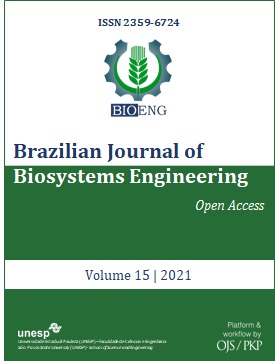ACAN SPEED, ATTACK ANGLE AND CUTTING FORCE, AFFECT THE QUALITY OF SUGARCANE HARVEST?
DOI:
https://doi.org/10.18011/bioeng2021v15n3p469-483Keywords:
Mechanization, Stalk damage, Machine tests, LossesAbstract
The base cut of cultures is one of the most studied parameters, and the variables involved in this process should be better evaluated under controlled conditions. The aim of this study was to evaluate, using an electromechanical device, under controlled conditions, the influence of the cutting angle and the machine's translation speed on the impact force generated on sugarcane stalks in mechanized harvesting. The study was carried out at the Nempa - Center for Testing of Agroforestry Machines and Tires (NEMPA) at UNESP/Botucatu. For the tests, the Sugarcane Basal Cut Testing Device (BCTD) was used. The collected data were evaluated using multiple linear regression analysis, using the stepwise method. The results showed that the angulation of the cutting blades is the most significant variable in relation to the impact force generated in the cutting process of sugarcane stalks, this research also managed to assess that the intensity of the angulation effect is more than 2 times greater than the effect generated by the displacement speed in the mechanized harvesting process.
Downloads
References
BERNACHE, L.; TEDESCO-OLIVEIRA, D.; OLIVEIRA, L.P.; CORRÊA, L.N.; SILVA, R.P. Can basal cutting blade wear affect sugarcane regrowth? Engenharia Agrícola, Jaboticabal, v. 40, n. 1, p. 53-60, 2020.
BISQUERRA, R.; SARRIERA, J. C.; MARTINEZ, F. Introdução à estatística: enfoque informático com o pacote estatístico SPSS. Porto Alegre: Artmed, 2004.
CASSIA, M.T.; SILVA, R.P.; PAIXÃO, C.S.S.; BERTONHA, R.S.; CAVICHIOLI, F.A. Desgaste das lâminas do corte basal na qualidade da colheita mecanizada de cana-de-açúcar. Ciência Rural, Santa Maria, v. 44, n. 6, p. 987-993, 2014.
CONAB, Acompanhamento da safra brasileira, primeiro levantamento - safra 2019/2020 - dezembro/2020. Brasília, 2020. Disponível em: <http://www.conab.gov.br>. Acesso em: 06 de abril de 2021.
FÁVERO, L. P. L.; BELFIORE, P. P.; SILVA, F. L.; CHAN, B. L. Análise de dados: modelagem multivariada para tomada de decisões. Rio de Janeiro: Elsevier, 2009.
FIELD, A. Descobrindo a estatística usando SPSS. 2. ed. Porto Alegre: Artmed, 2009.
GUJARATI, D. N.; PORTER, D. C. Econometria básica. 5. ed. Porto Alegre: AMGH, 2011.
LANÇAS, K. P.; MARQUES FILHO, A. C.; MOURA, M. D. S., DAMASCENO; F. A. D. J.; BALESTRIN, D. R. Agricultural Tractor Test. Revista Ciência Agronômica, v.51, s.ed., 2021.
MARTINS, G. A. Estatística geral e aplicada. 3. ed. São Paulo: Atlas 2010.
MARTINS, M. B.; MARQUES FILHO, A. C.; DRUDI, F. S.; BORTOLHEIRO, F. P. D. A. P.; VENDRUSCOLO, E. P.; ESPERANCINI, M. S. T. Economic Efficiency of Mechanized Harvesting of Sugarcane at Different Operating Speeds. Sugar Tech, v.23, n.2, p.428-432, 2021.
MATHANKER, S.K.; GRIFT, T.E.; HANSEN, A.C. Effect of blade oblique angle and cutting speed on cutting energy for energy cane stems. Biosystems Engineering, v. 33, n. 1, p. 64-70, 2015.
SILVA, M.A.; HOLANDA, L.A.; SARTORI, M.P.; GERMINO, G.H.; BARBOSA, A.M.; BIANCHI, L. Base cut quality and productivity of mechanically harvested sugarcane. Sugar Tech, v. 22, n. 2, p. 284–290, 2020.
VOLTARELLI, M.A.; PAIXÃO, C.S.S.; ZERBATO, C.; SILVA, R.P.; GAZZOLA, J. Failure mode and effect analysis (FMEA) in mechanized harvest of sugarcane billets. Engenharia Agrícola, Jaboticabal, v. 38, n. 1, p.88-96, 2018.
VOLTARELLI, M.A.; SILVA, R.P.; CASSIA, M.T.; DALOIA, J.G.M.; PAIXÃO, C.S.S. Qualidade do corte basal de cana-de-açúcar efetuado por facas de diferentes angulações e revestimentos. Revista Ciência Agronômica, Fortaleza, v. 48, n. 3, p. 438-447, 2017.
VOLTARELLI, M.A.; SILVA, R.P.; CASSIA, M.T.; ORTIZ, D.F.; TORRES, L.S. Qualidade do corte basal de cana-de-açúcar utilizando-se de três modelos de facas. Engenharia Agrícola, Jaboticabal, v. 35, n. 3, p. 528-541, 2015.
Downloads
Published
How to Cite
Issue
Section
License
Copyright (c) 2021 The Authors

This work is licensed under a Creative Commons Attribution 4.0 International License.
By publishing in this journal, authors agree to the following terms:
a) Authors retain copyright and grant the journal the right of first publication. The work is simultaneously licensed under the Creative Commons Attribution License, which permits sharing and adaptation of the work with appropriate credit to the authors and the journal.
b) Authors may enter into separate, additional agreements for non-exclusive distribution of the published version of the work (e.g., posting to an institutional repository or inclusion in a book), provided that proper credit is given to the original publication in this journal.










